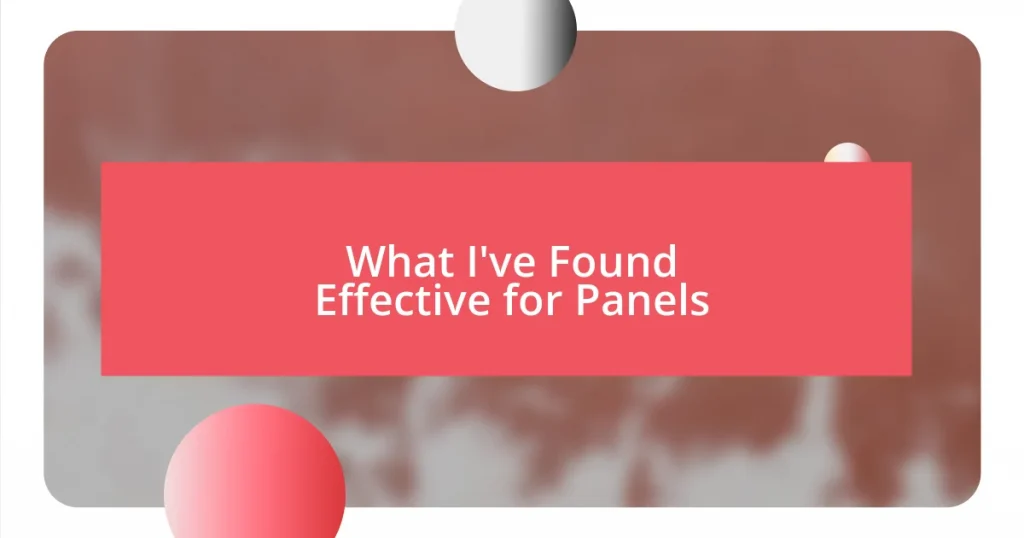Key takeaways:
- Utilize facilitation techniques like active listening, silent brainstorming, and open-ended questions to create an inclusive environment and enhance participant engagement.
- Key skills for effective facilitation include adaptability, creating a safe space for dialogue, and strong time management to align discussions with participants’ needs.
- Evaluate outcomes through participant feedback and observe behavioral changes, focusing on both tangible results and emotional shifts to gauge the success of facilitation sessions.

Understanding Facilitation Techniques
When I first stepped into the role of a facilitator, I quickly realized that understanding various facilitation techniques is crucial for success. Techniques like active listening and summarizing can transform a meeting, allowing everyone to feel heard and valued. Have you ever noticed how even the quietest voices can shine when the right techniques are applied?
One technique that has served me well is the “silent brainstorming” method. At a recent workshop, I encouraged participants to jot down their ideas silently for a few minutes before sharing. The room was filled with an electric energy, and I could see how this approach helped to foster a more inclusive environment. It felt incredible to observe how everyone, regardless of their usual participation level, contributed unique insights.
I often reflect on the power of open-ended questions as a facilitation tool. When I ask, “What are your thoughts on this approach?” instead of leading with a yes/no query, I can feel the energy shift. It’s like opening a door to a deeper conversation. How often have you felt that a simple question could lead to a significant breakthrough in dialogue?

Key Skills for Effective Facilitation
Effective facilitation hinges on several key skills that I’ve honed through experience. One of the most critical skills is adaptability. In a recent session, I found that the planned agenda didn’t align with the participants’ needs, so I pivoted our focus based on their input. It felt rewarding to witness the group’s engagement surge as we aligned our discussions with their interests and needs.
Another essential skill is the ability to create a safe space for dialogue. I once facilitated a team meeting where trust was low. By openly sharing my own uncertainties and encouraging others to do the same, the atmosphere shifted dramatically. These moments of vulnerability can forge stronger connections among participants, leading to more honest and fruitful discussions.
Lastly, strong time management is vital for keeping the conversation on track. During a workshop last month, I implemented a timer for each segment. This not only kept things moving but also motivated participants to express their thoughts succinctly. I find that respecting time shows appreciation for everyone’s contributions, making them feel valued in the process.
| Key Skill | Description |
|---|---|
| Adaptability | The ability to adjust the facilitation process in response to group dynamics and needs. |
| Creating a Safe Space | Encouraging open dialogue by establishing trust and vulnerability among participants. |
| Time Management | Effectively managing the time allocated for discussions to ensure all topics are covered. |

Preparing for Successful Meetings
Preparing for successful meetings starts long before the actual gathering. I’ve learned that attention to detail during the preparation phase often leads to smoother discussions. For instance, I remember one meeting where I meticulously organized all resources and related documents beforehand. The result was a focused session where everyone felt equipped and ready to contribute. It’s those little things, like having a clear agenda and pre-meeting materials, that can make a significant difference in engagement.
- Define the meeting purpose: Clearly articulate what you hope to achieve.
- Set a clear agenda: Outline topics to be discussed to keep everyone aligned.
- Gather necessary materials: Provide handouts or resources so participants come prepared.
- Invite the right people: Ensure that the participants are relevant to the meeting’s goals.
- Schedule wisely: Choose a time that accommodates everyone involved for maximum attendance.
- Follow up after the meeting: Send out notes and action items to reinforce accountability.
Preparing well feels like a warm embrace before the main event, and I’ve seen how it energizes the participants, setting the tone for effective collaboration.

Engaging Participants in Discussion
Engaging participants in discussion requires a mix of energy and empathy. I always aim to initiate conversations with thought-provoking questions that resonate on a personal level. For example, during a recent brainstorming session, I asked participants how their individual experiences tied into the project at hand. This not only sparked lively dialogue but also made each person feel valued, as their unique perspectives were woven into the fabric of our conversation.
I’ve found that using a variety of engagement techniques, like small group discussions or interactive polls, really keeps energy levels high. Just last month, I introduced a quick poll in a training session, and the immediate feedback lit up the room. It was fascinating to see how participants were not only eager to express their opinions but also excited to see the collective results unfold. This sense of involvement turns passive listeners into active contributors, and that transformation is incredibly fulfilling to witness.
To maintain momentum, I encourage participants to build on each other’s ideas. This collaborative energy creates a dynamic atmosphere where everyone feels inspired to share. I remember one session where someone built upon a comment in such a clever way that it prompted a chain reaction of creative thoughts. I thought, “Wow, this is the magic of discussion!” When participants feel empowered to connect their thoughts, deep and meaningful discussions emerge, leading us to unexpected yet valuable insights.

Managing Group Dynamics
Managing group dynamics is pivotal in ensuring that every participant feels heard and valued. I recall a time when I facilitated a workshop during which one participant’s voice dominated the conversation. It made me realize that stepping in gently to encourage other voices was essential. I raised my hand and said, “Let’s hear from someone who hasn’t had a chance yet.” That shift brought forth a range of perspectives and transformed the mood of the room, illustrating the importance of balanced participation.
Building trust within the group is another crucial element I focus on. I once shared a personal story that was relevant to the topic and saw immediate changes in the room’s energy. It was as though my vulnerability opened a door for others to share their thoughts and feelings. I truly believe that when participants feel safe, they’re more willing to express their ideas and even challenge the status quo in a respectful manner. Who wouldn’t want to collaborate in a space where honesty flourishes?
Lastly, recognizing non-verbal cues plays a significant role in managing group dynamics. I remember sitting in a meeting where I noticed someone nodding vigorously but not speaking up. After a moment, I asked them directly, “What are your thoughts? I can see you have something to say.” This not only empowered that individual but also reminded the whole group to pay attention to the silent voices among us. When we tune into these signals, we foster inclusivity, and that’s where the real magic happens.

Closing Conversations Effectively
Closing conversations effectively is just as crucial as initiating them. Often, I find myself remembering a particular meeting where we reached a natural conclusion. I encouraged participants to share their key takeaways before we wrapped up, and it was enlightening to hear diverse perspectives crystallize into succinct summaries. Isn’t it fascinating how reflecting on our discussions can reinforce their significance and etch them in our minds?
Equally important is creating a sense of closure that allows participants to leave with a feeling of accomplishment. After a lengthy workshop on team dynamics, I concluded by inviting each participant to share one action they planned to implement. The energy in the room shifted dramatically as ideas flowed, and it felt like we were not just closing a session but launching into practical application. Who doesn’t want to feel that sense of purpose when they step out of a conversation?
Finally, I’ve learned that establishing follow-up opportunities can significantly enhance the closing process. After a brainstorming session, I’ve sent out a brief recap email highlighting key points and next steps. The feedback I received from participants was overwhelmingly positive; many expressed appreciation for the clarity it provided. It made me wonder: what if more facilitators prioritized this kind of follow-through? By ensuring that discussions have lasting impact, we reinforce the value of collaborative efforts.

Evaluating Facilitation Outcomes
Evaluating facilitation outcomes isn’t just about looking at the tangible results; it’s also about understanding the group’s emotional journey throughout the process. I remember a session where participants initially seemed disengaged, but by the end, their faces illuminated with enthusiasm. This shift was a powerful indicator of success that went beyond just meeting the agenda. Have you ever experienced that moment when you realize the energy in the room has completely transformed? It’s magical and enlightening.
To truly assess how successful a facilitation session has been, I often employ feedback tools like anonymous surveys. After one particular workshop, I was taken aback by a comment that mentioned feeling a “refreshing sense of clarity.” It struck me how a simple question about their experience could unlock valuable insights for future sessions. This kind of feedback is not just about affirmation for me; it serves as a vital compass, guiding me in evolving my approach. Isn’t it intriguing how one piece of feedback can reshape our strategies?
Additionally, I’ve learned that observing changes in participant behavior is a telling sign of effective facilitation. In one workshop, I noticed that participants hesitated to contribute ideas at first, but as we moved along, they began to build on each other’s thoughts. It was then I realized my role transcended just guiding discussions; I was nurturing a thriving ecosystem for collaboration. How satisfying is it to witness a group flourish, transforming into a cohesive unit eager to share and innovate? It’s moments like these that affirm the value of intentional facilitation.













